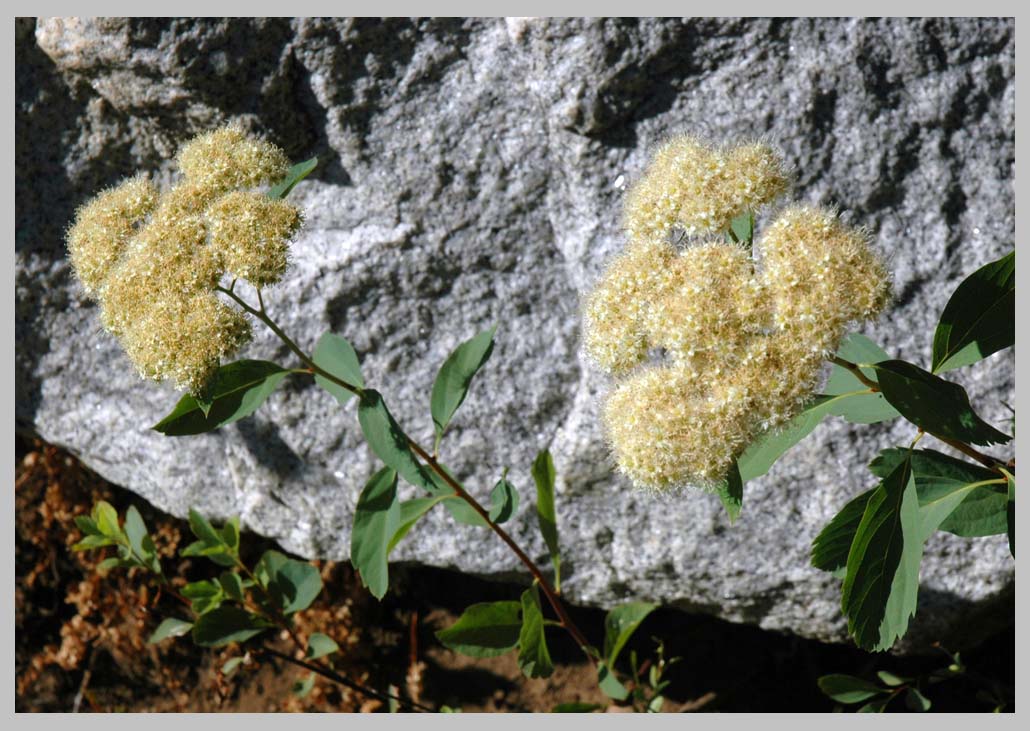

White Meadowseet, or White spiraea (Spiraea betulifolia)
On the road in the American Northwest. [ click photo for next . . . ]


White Meadowseet, or White spiraea (Spiraea betulifolia)
On the road in the American Northwest. [ click photo for next . . . ]
Rose Meadowsweet, or Mountain spiraea (Spiraea densiflora)
is a small, colorful mountain shrub that comes into its
own at about 1700 meters in the Wallowas. Here, it takes
over from its forest cousin, also a member of the Rose family,
the White spiraea (Spiraea betulifolia) in much the same way
that Mountain elderberry (Sambucus racemosa, with blue berries,
not red) takes over from Western (Sambucus coerula) at higher,
more open, elevations. The Wallowa meadowsweets are a primary
source of oil of wintergreen, or methyl salicylate, a compound
with similar analgesic properties to aspirin. I like to chew
on twigs as I walk along trails making photos.
Rose Meadowsweet or Mountain spiraea (Spiraea densiflora)
Eagle Cap Wilderness . . .
[tweet 3,608 IX.18.201
Solar will replace oil as easily as digital cameras
replaced their analog counterparts. It’s hard to stop
what’s better in almost every way.
2]
AN EXTINCTION OF A DIFFERENT KIND
Of all the extinctions currently underway—we are told we are at the dawn of
planet Earth’s sixth great extinction, with, for example, a quarter of all mam-
mals under threat, as well as a third of all frogs, to mention but a few—the one
that saddens and frightens me most receives little if any attention. It is the ex-
tinction of the free spirit. By “free spirit,” I mean exactly that: an intelligence
that is not tied to anything, and which can therefore find out the truth of a mat-
ter with integrity, independence, and, most especially, without fear of loss.
This is the man or woman, young or old—age here makes no difference—
who is capable of examining a thought or idea and following it like a thread
through a labyrinth of possible dead-ends, missed implications and inconsis-
tencies, to its logical ground and source.
My contention is that the man or woman of free spirit is becoming exceedingly
rare. I hope that I’m wrong.
THOUGHT EXPERIMENTS OF THE
COMPASSIONATE MIND
When strings at rest reflect in sympathetic resonance
other sounds near them, we hear the birth of Love &
Compassion in the physical world.
A key feature of the compassionate mind is evidently its need to move
freely with the unseen relational resonances implicit in every produced
or used artifact, every thought, every action. The apple may indeed
be superficially beautiful, but to ask how, where and by whom it was
grown, is a quintessentially spiritual question.
For the student of any age, the key thought experiment is: begin with
the end, or manufactured object, and then unravel it into its many
simpler constituent threads or parts, thereby going back in time and
space like a movie playing backwards. Imagine all the objects in a room
returning to their ultimate earth-bound source in this way. And then, run
the movie in your mind’s eye fast-forward until all the objects converge
again into their motionless, present form.
What parts of the movement are necessarily so? What parts are waste-
ful? What parts cause harm? Which objects do you now see as neces-
sary? Which do you see as wasteful?
It is the beginning of a much wider circle of ethical awareness.
Hummingbird Pass,
Eagle Cap Wilderness,
Oregon, X.29.2008
THE LITTLE CLAVIER please preview 150 of 631 pages
w/ my black & white photography [opens in new window]
Let me know how you like it!
NEW: To view / purchase high quality prints & matted frames
at the Photoweek Northwest online store, SLIDESHOW
http://picturepoems.zenfolio.com/
All Photographs & texts by Cliff Crego © 2012 picture-poems.com
(created: IX.18.2012)